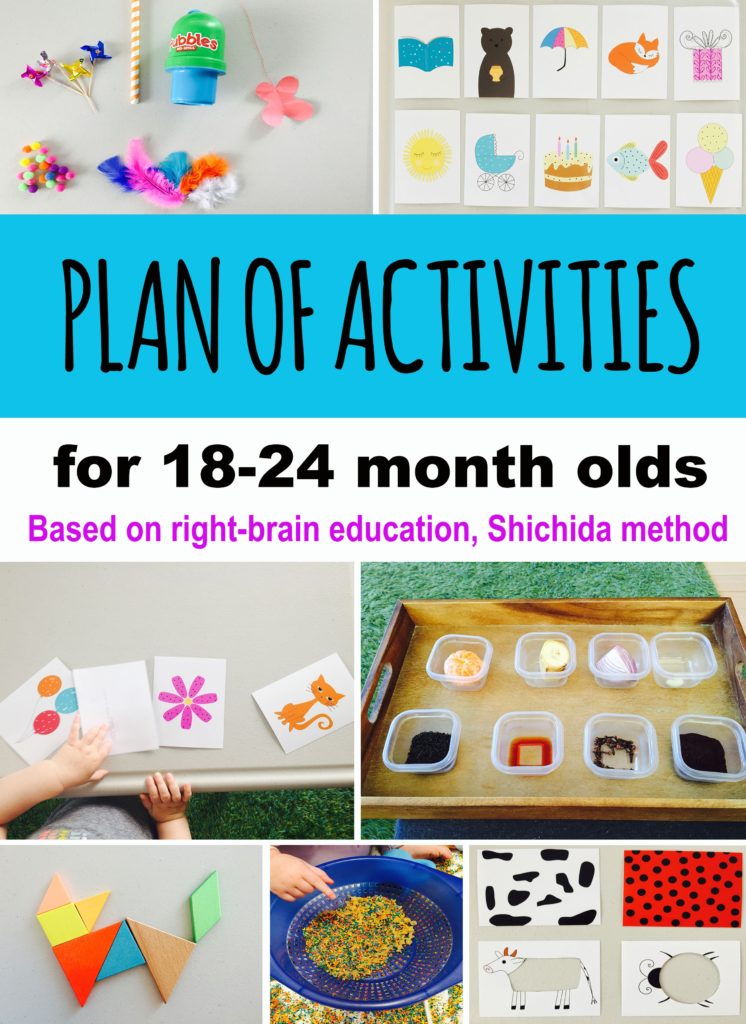
I recently discovered a fascinating educational method by Makoto Shichida, that focuses on the development of the child’s right brain. I’ve been overwhelmed with interesting information and started to apply it to our activities with my toddler right away. It’s not easy to find detailed information about his method online, and his books in English are only available from Japan. So I ordered his book – if anybody is interested it’s here or you can read my summary below. Besides reading the book, I gathered information from parents whose kids went to Shichida schools in Asia, so here is a recap of what I learned and how we implement it with our 19-month-old.
As you know, left brain controls things like logic, written and spoken languages, scientific ability and number skills. The Shichida method targets the development of the right brain which is responsible for the photographic memory ability, computer-like calculation ability, intuition and creative imagination. All these skills can be acquired by doing exercises that stimulate the right brain. The idea of my child having these skills sounds very exciting to me, considering that I have a very bad memory. If I can help my child develop even some of these skills, I would consider myself an accomplished parent.
Both parts of the brain have different information processing methods. The left brain processes information via language while the right brain processes information via sensory images stored in the memory. The right brain’s capabilities are all connected through these images. Children who develop right brain memory can instantaneously memorize what they see, as if they are taking a photograph. The left brain is the brain of words, we use it every day so it’s well developed. In order to make the right brain work well, it’s important to do image training every day (described in exercises below).
Two brains develop in a certain order. First, the right brain is dominant. From about age three, when logical and linguistic thinking are starting to develop, dominance will shift to the left brain. The younger the child learns image memory methods, the more natural photographic memory becomes. That’s why it’s so important to start practicing right-brain activities before kids turn 3 years old.
In case you are wondering if this method only develops right part of the brain, the answer is – the activities include both: exercises for right and left brain, in fact, a lot of Shichida teaching is based on Montessori method.
According to Dr. Shichida, the idea is not to cram kids with knowledge but to teach them the capability to learn very fast when they need to later.
The duration of each session should not exceed 30 minutes a day, and the child should be doing free play for the rest of the day. Ideally all activities should be done in one sitting, but they can also be spread out throughout the day. Scarlett is 19 months old now, she’s a very active child and so far she wasn’t able to sit still through the whole activity session so we do the activities throughout the day for now. But as a parent, it’s nice to know that doing activities for 30 minutes a day is enough.
Here is an approximate plan of the activities. I’ll write about how they are supposed to be done and how we adapt each activity for us.
One important note – each exercise below should last only 1-2 minutes.
This information was a relief for me, because my toddler loses interest in activities very fast. And in the past when I tried to make her do one activity for a while, she would walk away. Having activities change fast, and having them last under one minute made her more interested in the activities, and made me feel good that it’s ok.
First block of activities includes prep activities that are meant to relax the child and activate right brain.
1.Relaxation
It’s recommended to turn on the music with alpha-waves which stimulate the learning abilities. I usually search for music with alpha waves on youtube or spotify.
2. Breathing and blowing exercises
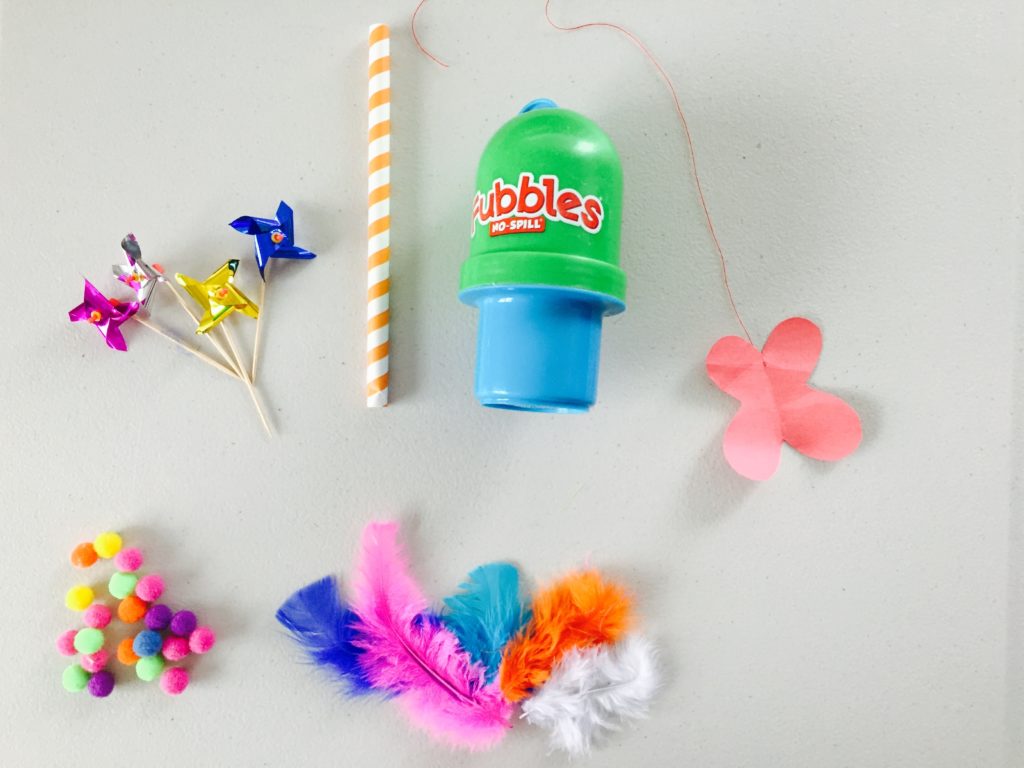
Meditation and breathing practice is necessary to prepare to switch from left dominance of the brain to right.
These activities are also part of the prep block and include breathing exercises for older kids, and blowing exercises for younger kids. Blowing activities are also essential for the development of facial muscles and have tremendous importance in the development of speech.
Here are some blowing activities that we do with our 19 month old:
- Blowing pompoms off the table. We use small pompoms because it’s easier for a toddler to blow them off the table.
- Blowing pompoms into a box on the table.
- Blowing a candle.
- Blowing bubbles.
- Blowing feathers to make them fly.
- Blowing mini pinwheels.
- Blowing on a paper butterfly attached to a thread to make it fly.
- Blowing bubbles in a cup of water with a straw.
- Blowing cute whistles
3. HSP exercises (Heightened Sensory Perception).
This block of the activities targets the development of intuition and includes intuition or guessing games. According to Dr. Shichida, a child can develop intuition by doing exercises from early on. We have been doing guessing games before I came across this method and Scarlett always liked these types of games.
Here are some guessing games that we play:
-
The cups game
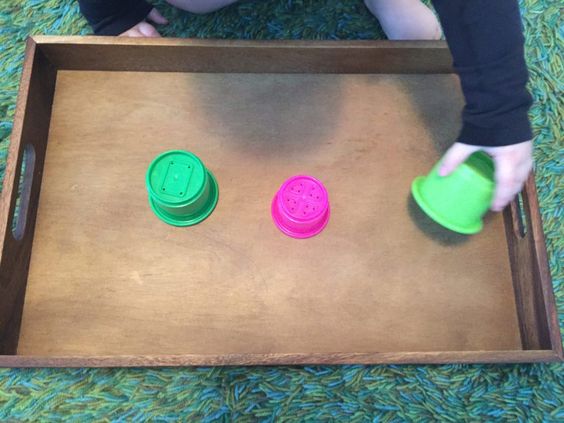
Place a small toy underneath one the cups, shuffle the cups and ask your child to guess where the toy is.
-
“Little mouse, are you in a red house” game

Hide a mouse under one of the houses and ask your child to guess which house a mouse lives in. A printable for this game is available in this post that I wrote earlier.
-
Hiding a toy in your hand.
Take a small toy and hide it in your fist. Show 2 fists to your child and ask her or him to guess which hand a toy is hiding in.
-
Look for the toy in boxes
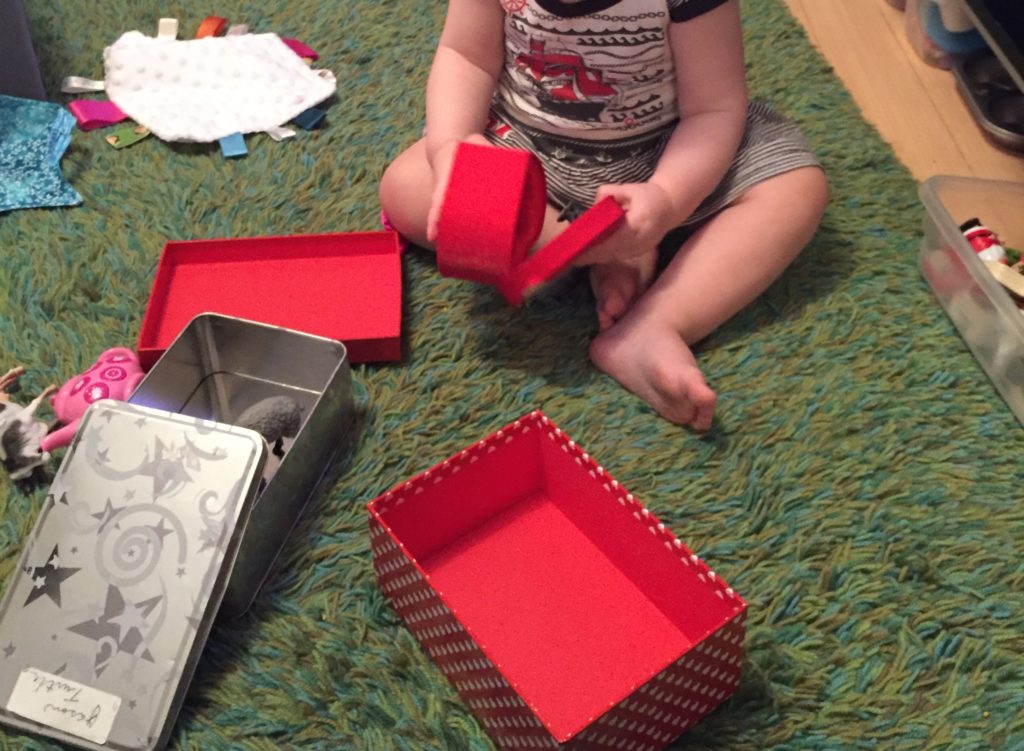
Hide a toy in one of the 3 boxes and ask a child to guess where the toy is.
Shichida method supposes using a different game each time you do the activities, to keep the child interested.
I’m not sure if it’s realistic to do a totally different activity in a home environment since we can only prepare/buy a limited amount of supplies, so I try to have longer breaks between each repetition of the game. There are still ways to diversify the same activity with different materials. For example, we hide different toys in different places – we hide large toys behind different large objects (pillow, book, towel, chair), we hide small toys underneath cups of different material and size, inside boxes, plastic eggs, and bags. The houses from the little mouse game can be used to hide some other flat magnets or pictures. For older kids, you can also ask to guess what time daddy gets home, what will be the weather tomorrow, etc.
4. Instant memorization – Memory Grid and Linking Memory game.
This block of exercises develops photographic memory. Right brain can be used to memorize massive amounts of information at high speed. The left brain processes information in a linear way while the right brain memory works with a parallel processing method, thus allowing storing massive amounts of information instantly (photographic memory).
Linking memory game
Place 2-3 cards in front of the child, and start saying an absurd story linking these cards in the same order as they came out. The more absurd the story is, the better – the easier it is to remember it. For example, you have cards with a bear, an umbrella, and an ice cream – and you can say a story like that: “It was raining so a bear decided to go for a walk and he took his umbrella and went to get some ice cream.” Have your child take a look at the layout of the cards for 5-30 seconds, then hide the layout so your child can’t see it and ask your child to repeat the story. Increase the number of cards gradually until the child can remember 50. It’s harder for us – parents to remember the sequence of cards when there are a lot of them, so you can check with the layout that the child can’t see or you can take a picture of the layout, and compare the results with the picture. Once the child memorizes 50 cards, something amazing will happen – he or she will be able to memorize the order of the cards in one glance.
Try playing this game with family as well, we tried it, and it was so much fun!
This game is for kids that can speak well, we don’t do linking memory activity with my 19-month-old yet. We do memory activities below instead.
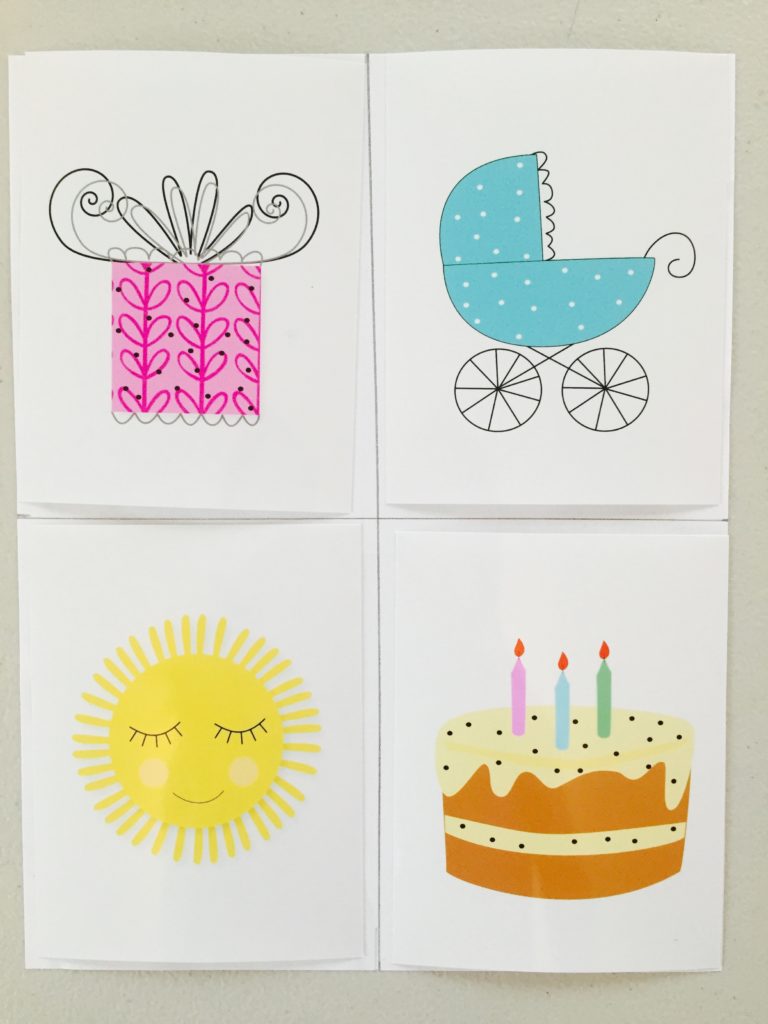
Memory grid
Take a sheet of paper and split it into sections that can fit a card in each section. You can start with a grid of 4 sections. Place one card in each cell. Have your child look at it for 5 secs and then hide it. Give your child a blank grid of the same size and the same set of 4 cards and ask to arrange them in the same order. Compare by revealing the original layout ( you will need 2 copies of each card for this) or as described above: take a picture of the layout and compare. Increase the grid size to 50 cards gradually. You’ll need a bigger sheet of paper to make a larger grid, or smaller pictures. Another option, is not to use a sheet of paper at all, and just lay out the cards in the shape of a grid on the table or carpet.
Here are some variations of memory games:
- Lay out 5 cards in front of the child. Then mix them up, add one new card, lay out 6 cards in front of the child. Ask which one is new.
- Lay out 5 cards in front of the child. Then mix them up, remove one card, lay out 4 cards in front of the child. Ask which one was removed.
- Arrange toys in front of the child, and place one item in front of each toy. Then mix items up, and ask which item belongs to which toy.
- Arrange small items in a plastic beads organizer like this one, and ask to remember the order how they were arranged.
What we do with our 19 month old:
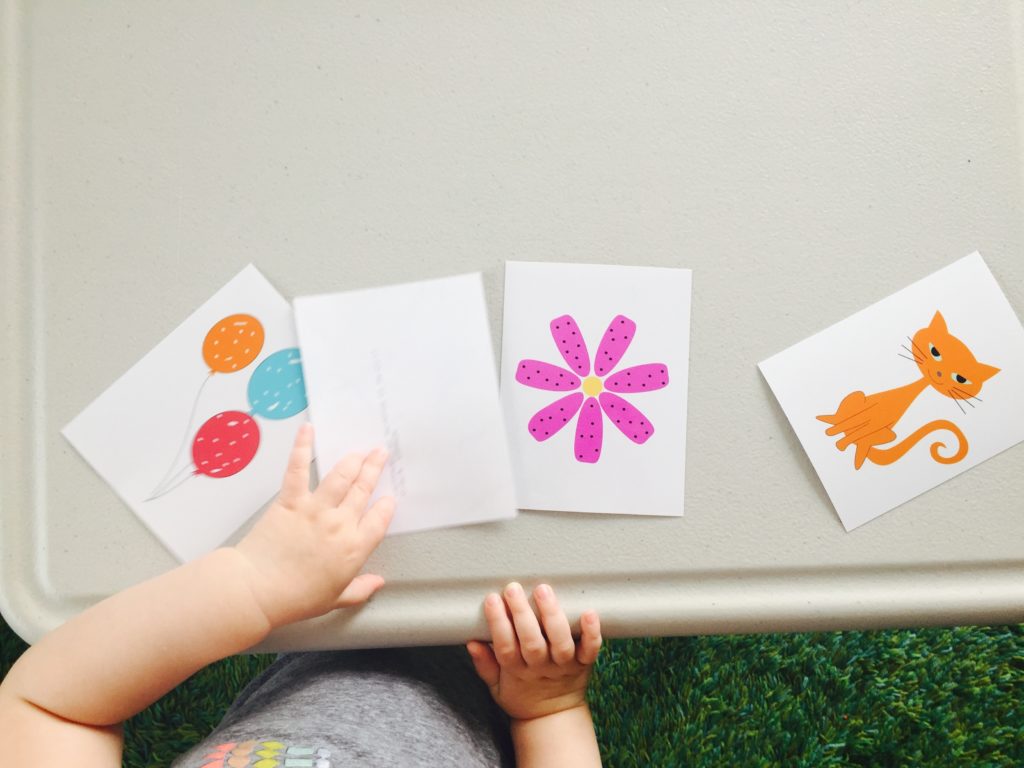
- Adapted memory grid with cards. I lay out 4 cards in front of Scarlett. I name them. Then I flip cards over and ask her where one of the cards is. For example, I lay out cards with balloons, a car, a flower, and a cat, I flip them over, without mixing, and then I ask her: “Show me where the flower is”. She flips a card and we check if she got it right. If she got it, I keep that card picture side up, and ask her to find a cat, and so on. The quantity of the cards can be increased as the child gets better at the game.
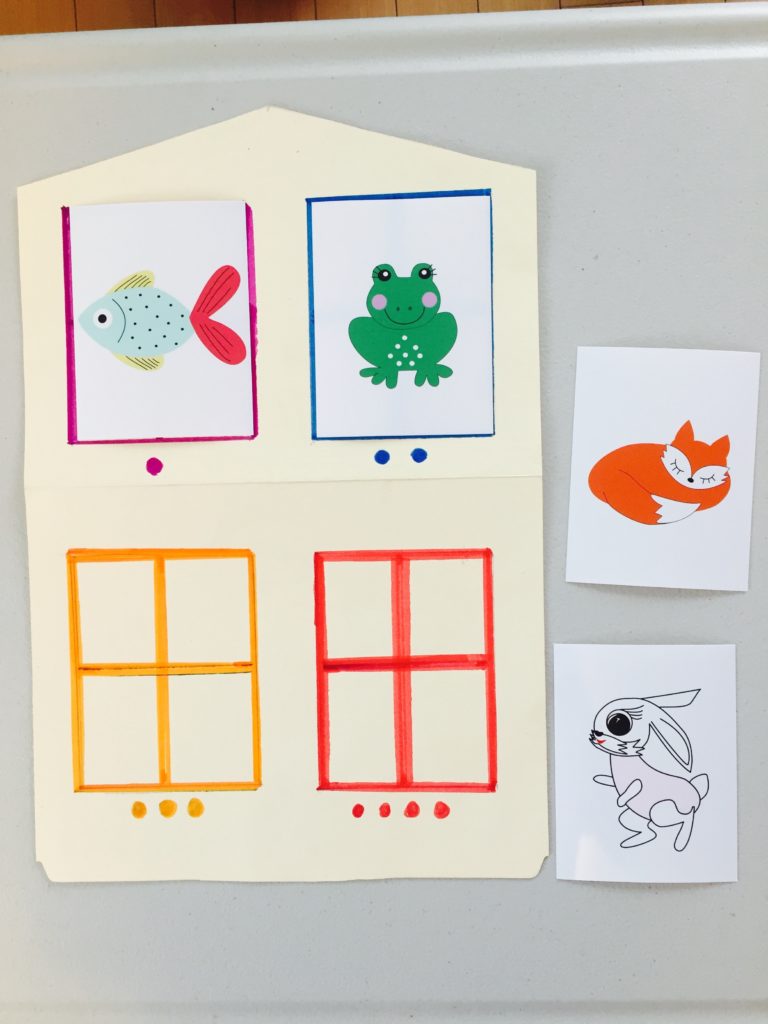
- Memory grid in a house. I made a memory grid in the shape of a house, which I cut out from manila file folder. I drew windows on it, and arranged cards in each window. After placing the cards on the windows, I say: “A fish lives in a purple window, a frog lives in a blue window, a bunny lives in a yellow window, a fox lives in a red window.” Then I remove cards, and ask her to place cards according to where each animal lives.
A digital version of the cards from the pictures above is available here. I printed those cards online at www.photoaffections.com/freeprints, this website allows a certain amount of free prints per month, I just paid for shipping. Printing them on photo paper makes them more durable, but they can also be printed at home.
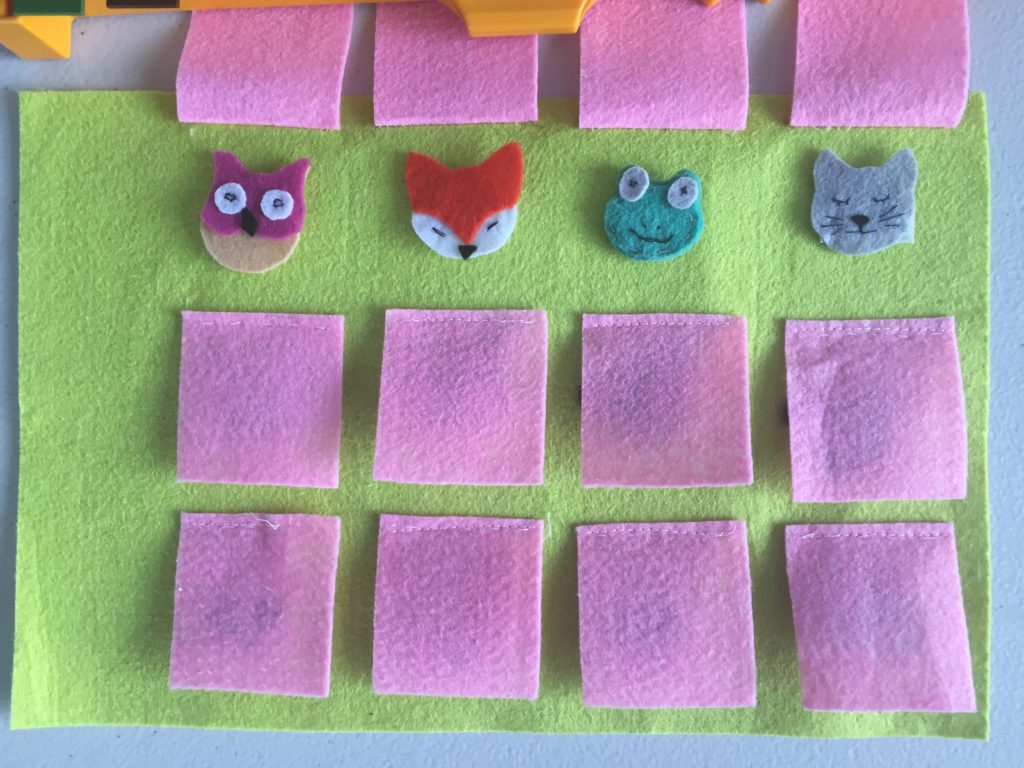
- Memory felt game. I made this quiet book page when Scarlett was little and I had more free time. There are 2 copies of each animal, which are attached behind the flaps on velcro. First, I show Scarlett where all animals are. Then, I ask her to find a cat. Once she finds it, we look for a second cat and then take them both off the sheet. This game can also be done with cards, you just need 2 copies of each card.
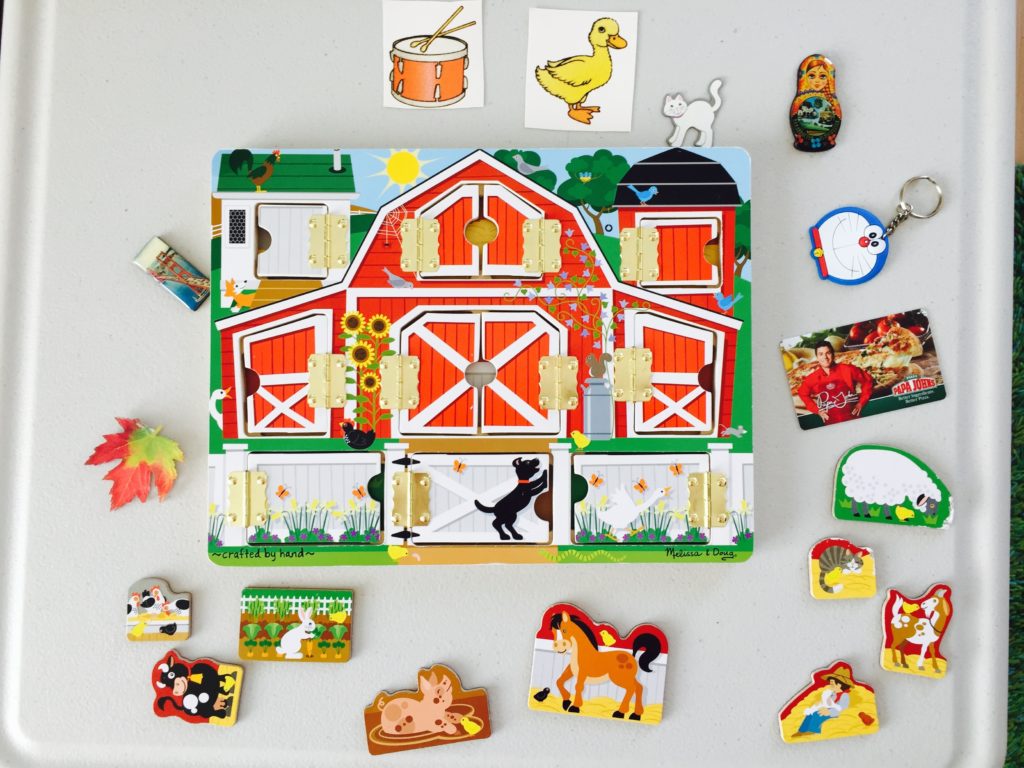
- Hide and Seek Board can be used for memory activity as well. Besides using magnets that come with the set, any other flat objects can be used to keep the game different every time. I added a few of the other magnets that we have, and cut out images from some old flash cards and postcards.
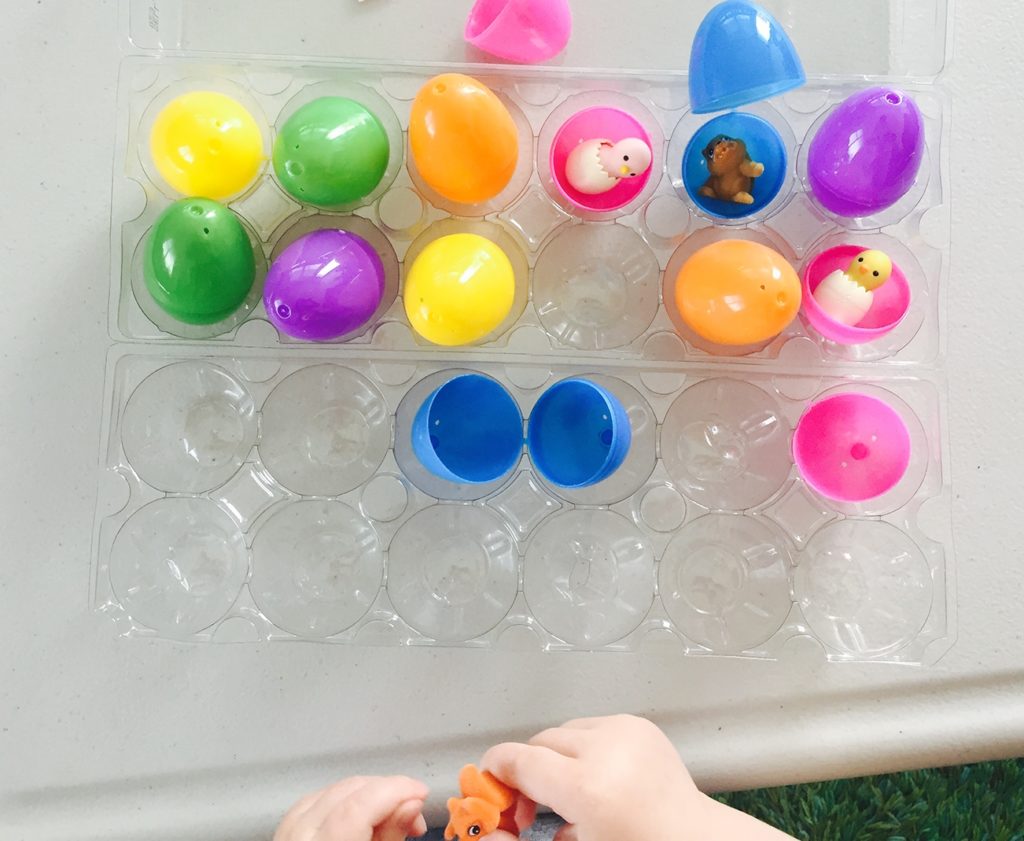
- Memory game using plastic eggs. We play the memory game with plastic eggs, following the regular memory game rules – looking for a pair for each toy. You’ll need plastic eggs and 6 pairs of small toys.
5. Speed-Reading Training – Mandalas.
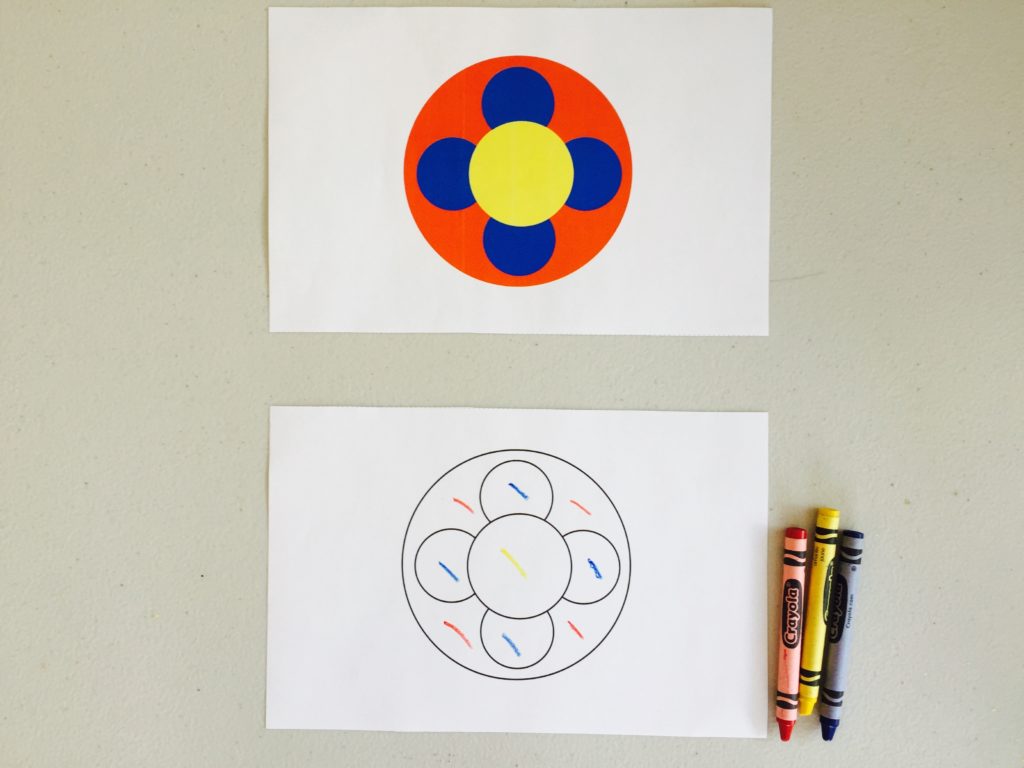
According to Dr Shichida, there is a finite number of shapes that make up everything in nature and the universe, once the child has seen every combination, he or she can spot and recall all the patterns in science and nature. This is a photographic memory exercise.
How it’s supposed to be done:
Images of mandalas are often used for this activity. You need 2 copies of the same mandala image: one colored, the other one black and white. Show a colored image to your child for 1 second, and then ask to color the black and white card according to the child’s memory (mandala doesn’t need to be fully colored, just leaving color dots on the mandala sections works as well). Compare the colors with the original card you showed. First, simple mandalas with 2 colors and simple shapes should be used, then, their colors and shapes can get more complex. This activity is, obviously, for kids that can color.
Younger kids can do a simplified version of this exercise:
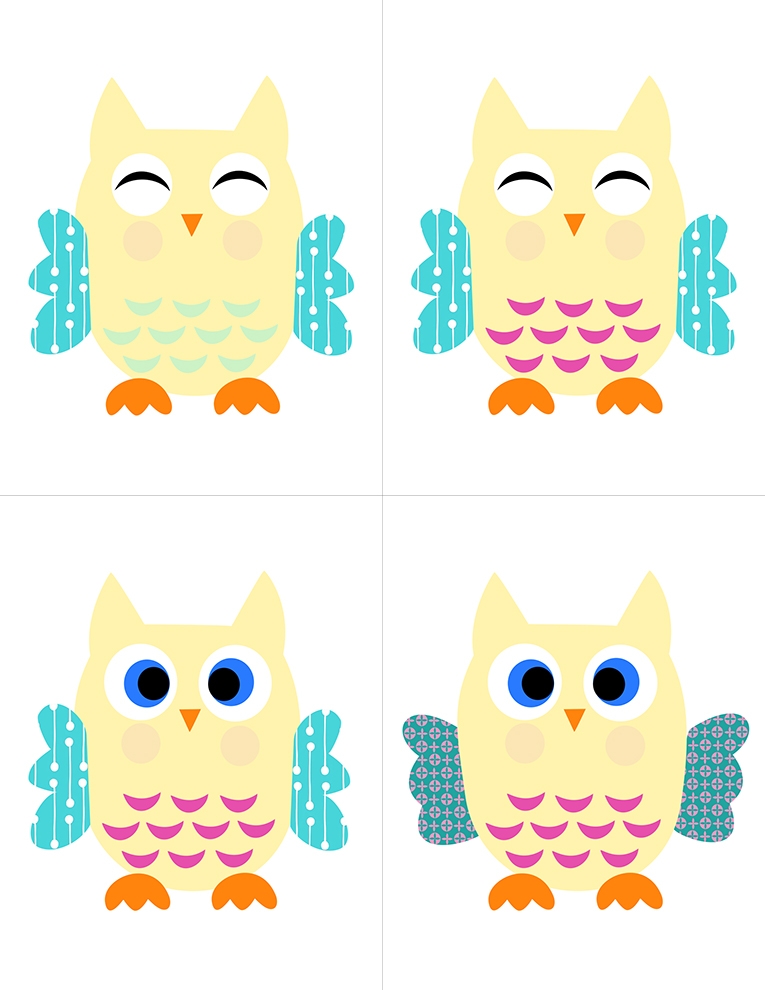
You’ll need a set of cards where each card has a pair that is slightly different. Show one card to the child for 1 second to memorize it, then lay out 2 similar cards in front of the child and ask to point to the card that you just showed. You can start with showing 2 very different cards, and then switch to more similar ones.
This set includes owls that differ from each other by one detail. Some owls have 2 similar cards, some have 4, so it can be used for different ages. You can download it here for free.
Next block of exercises is based on Montessori and left brain activities.
6. Puzzles.
Any age-appropriate puzzles could work for this block of activities. Here is a list of puzzles that we do with our 19-month-old. Please note that we only do 1 or 2 of these puzzles at each activity session.
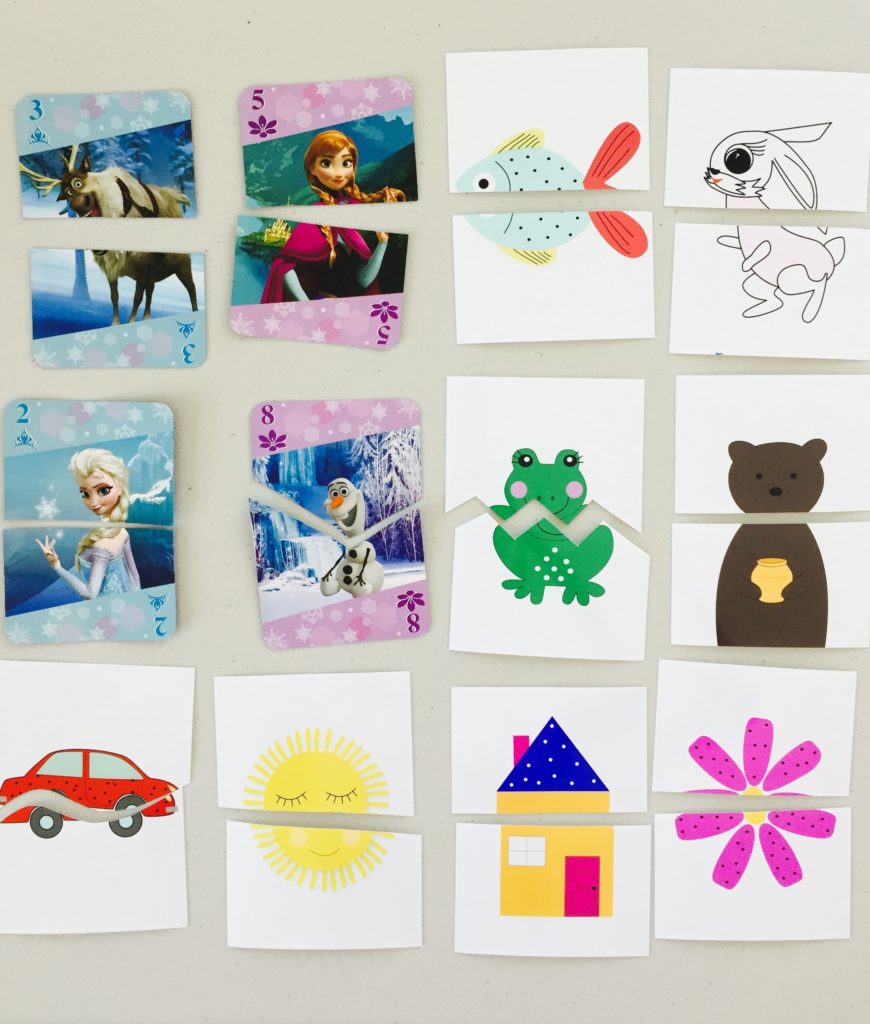
-
DIY Puzzles
It’s easy to make simple puzzles yourself. You can use flash cards, playing cards, or other cards by cutting them in half (or more pieces for older kids). We use the same cards that we use for memory games. I printed 2 copies of those cards on photo paper. We use one set for memory games, and the second set for puzzles – I cut each photo card into 2 pieces and give to Scarlett to put them together.
I also used Princess Playing Cards to make puzzles. It’s good to use cards with characters that your child likes.
We do around 2 picture puzzles at a time for now.
-
Animal skin puzzle
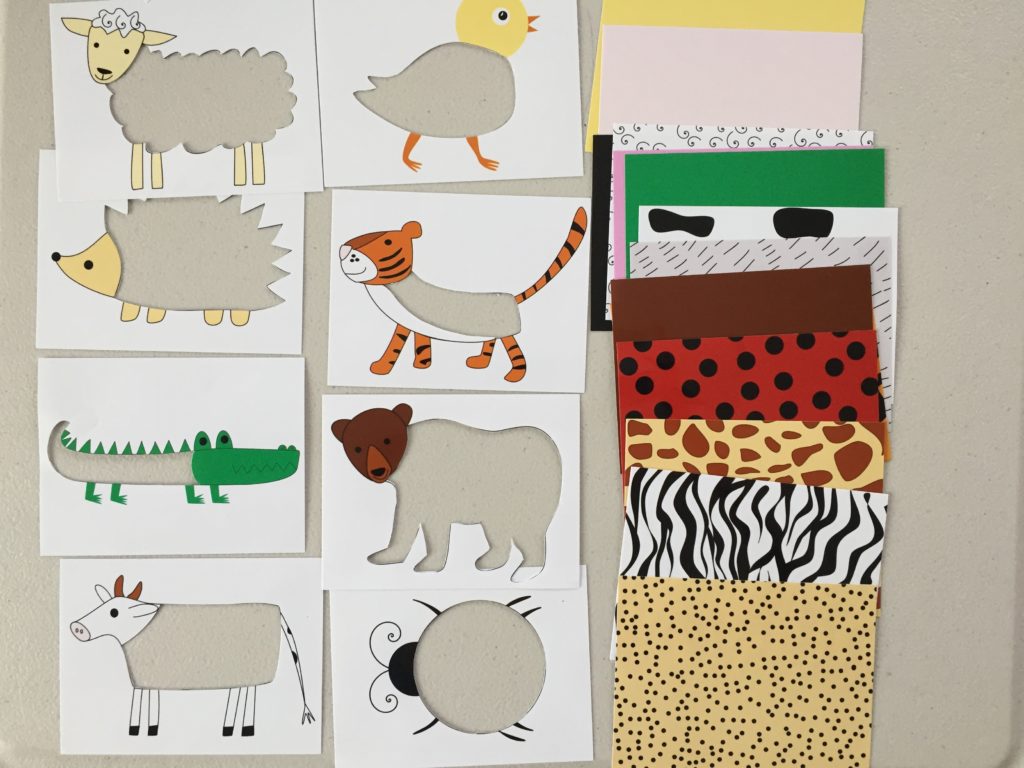
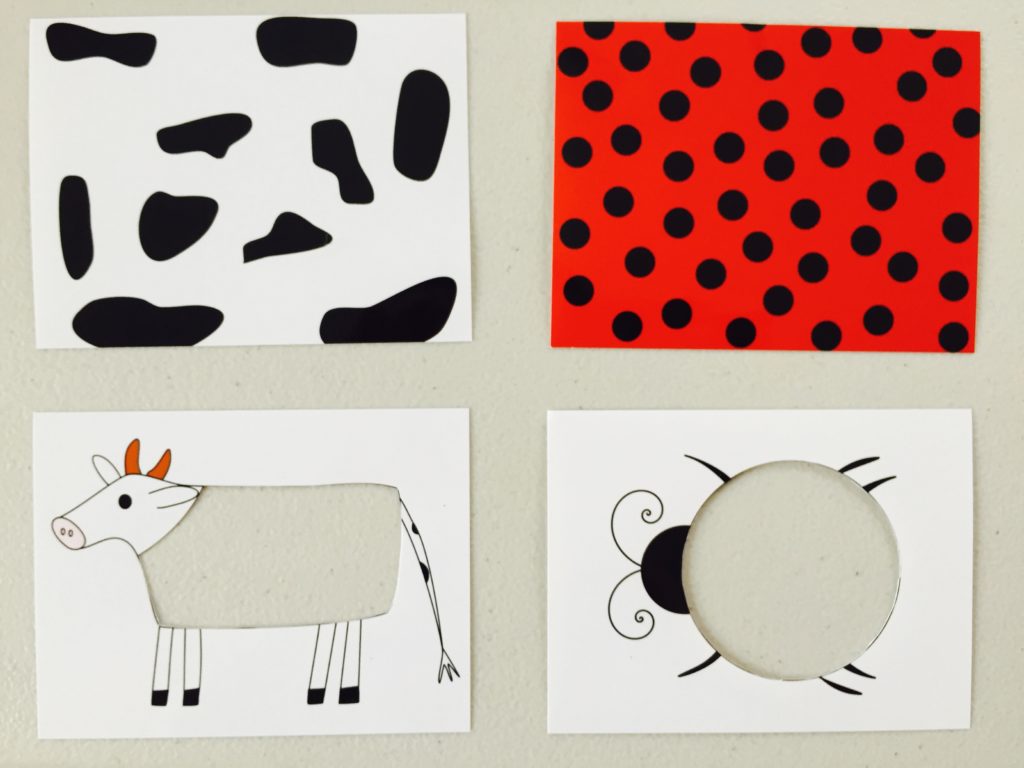
Another puzzle that we like is an animal skin puzzle that can be downloaded here for free. We printed images on photo paper and cut out the body part of each animal, and Scarlett gets to match different skins to different animals until she finds the right one. This game is a lot of fun!
-
Big and small concept games
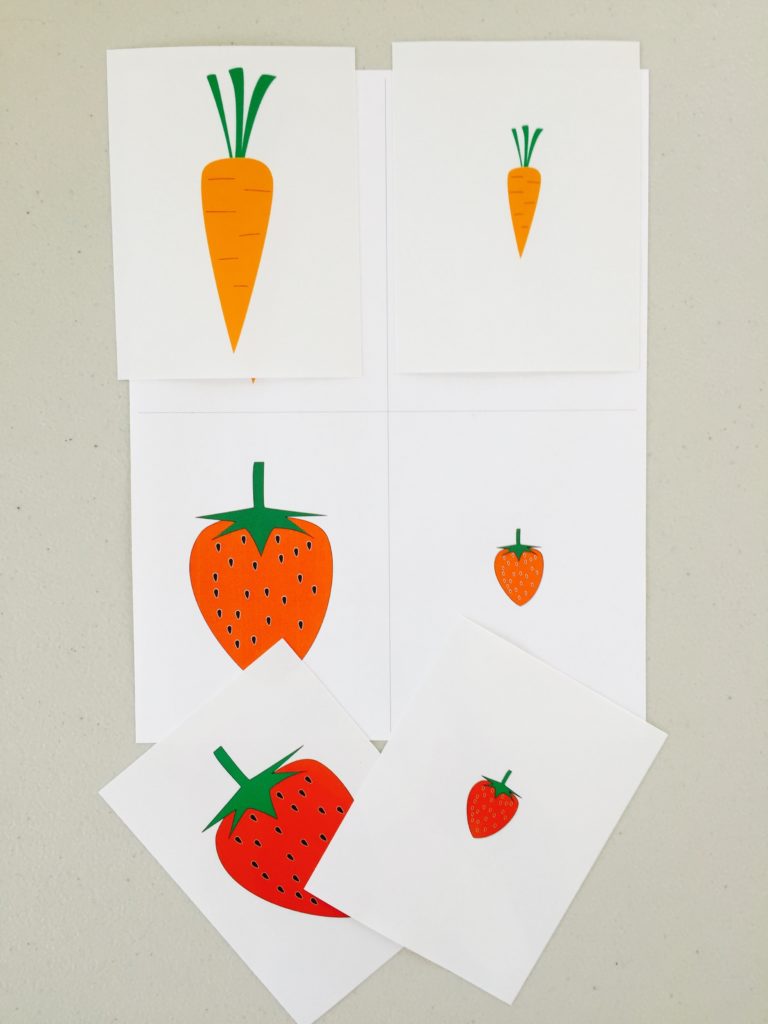
This printable can be downloaded here for free. The set includes 20 cards – 10 large, 10 small cards and a pdf file with a 4 section grid. There are 2 ways to play with this set:
- Place a printed grid sheet in front of the child, and have her or him place a matching card on each cell. This game is great for kids to see which image is big and which one is small, and also great for learning shapes, which are included in the set.
- Sorting cards into 2 piles – small images and large images.
We play the first version of the game with our 19 month old.
Some other activities we do in this block:
This puzzle is probably more appropriate for older kids, we had it at home because someone gave it to us as a gift. I was really surprised that Scarlett started to correctly place the pieces of this puzzle into the correct spots.
-
-
Sorting shapes
-
Probably every parent has a shape sorting puzzle or cube at home. We have this one. I put the letters away, and we concentrate on sorting the shapes for now.
Peg puzzles are great for toddlers because they have a self correcting mechanism – kids can see themselves when the piece doesn’t fit and try to correct it, and also because they have little handles for little hands. We like musical peg puzzles because of an added benefit – it produces music when a puzzle piece is placed.
-
Jigsaw puzzle
For those parents that don’t have time to make puzzles themselves, there is a variety of jigsaw puzzles for toddlers. We like Head and Tails Puzzle. Jigsaw puzzles are great because they also have a self correcting mechanism, as no 2 puzzle cuts are the same.
Since Shichida method recommends to have longer breaks between reusing the same activity, I found the easiest way to diversify is to make puzzles myself – use lots of cards/flashcards for puzzles. I prepared a bunch of them in advance – cut them in 2 halves and give Scarlett 2 cards each time we have an activity day.

-
Play with Peekaboo bunny
I’d really like to recommend this game for toddlers. It got a few awards for helping to develop child’s logical thinking and early mathematical skills. It comes with cards, a bunny and 3 wooden blocks. Cards show how the bunny needs to be arranged on the blocks, and the child needs to manipulate the wooden block to match the card. The cards are split into levels. It’s great for kids 2 years+, we started to play with the easiest level at 25 months.
-
Sequencing games
Sequencing games like this one are great for kids 2.5 years+. They teach kids logic how to assemble puzzles into sequencing events from left to right. They also have self correcting mechanism since as no two puzzle cards are the same.
7. Tangram.
Shichida method often includes an activity involving playing with tangram. Tangram can be purchased on amazon, or you can make one yourself. We bought a wooden one since it’s more durable, and later on I discovered a magnetic tangram which looks even better for a toddler. The tangram set includes small pictures of designs you can create. There are also books available with tangram designs. For now, we do one tangram design at each activity session. At this age, Scarlett mostly watches me do it, and then plays with blocks herself but hopefully she will get to building with me soon.
This block of activities can also include building with duplo, lego blocks or other building blocks.
8. Sensory play
Developing all child’s senses is also an important part of Shichida education. Age-appropriate sensory activities should be included in each session.
We usually do sensory activities at a different time of the day, since we like to spend more time with these activities. Here are some things that we do with our 19-month-old.
-
Rice play
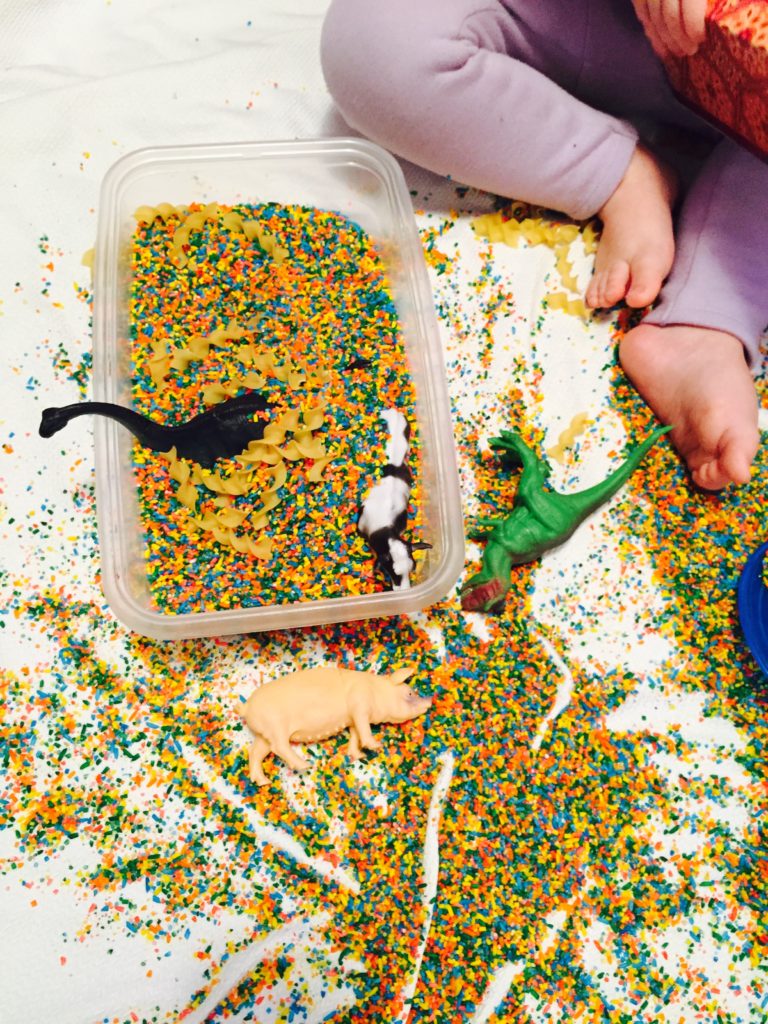
Rice play is a great sensory activity for kids of different ages. Older kids can play with themed sensory trays, while younger kids can do lots of sensory interactions with rice. I have an article that describes 12 ways to play with colored rice.
-
Smell sensory play

Smell sense is often omitted from sensory activities. We made this sensory tray with little containers filled with food items that have very distinct smells. I included tangerine, banana, onion, garlic, bergamot tea, vanilla, cloves and coffee. I put closed containers in front of Scarlett, we opened them one by one and smelled them. It did turn into a mess later 🙂 Older kids can play a great sensory game – have a child close his or her eyes and ask to guess the smell without looking.
-
Color matching game
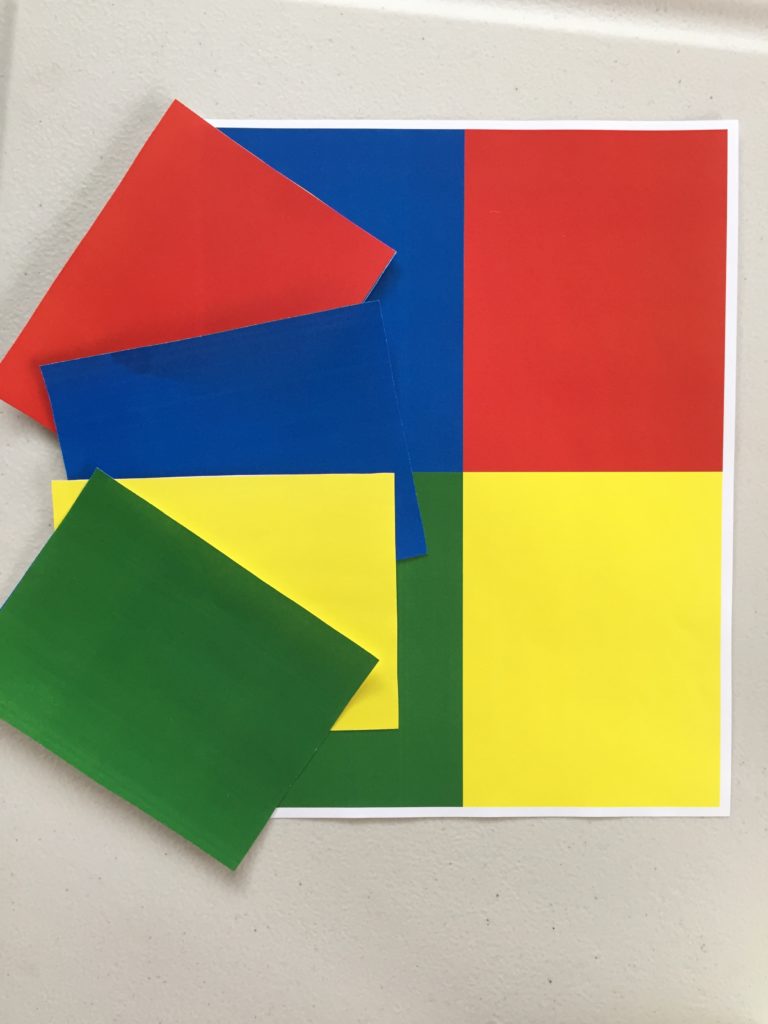
This is a very simple color activity for a toddler that is just learning colors. You can download this file here. Print 2 copies. Cut one of them into cards, and ask your child to place each card into a corresponding cell of the sheet.
Any color sorting or drawing/painting activities can be done in this section as well.
There are more ideas for sensory activities in my article: 10 Montessori activities for one year olds.
9. Physical activity
Physical activity is also an important part of Shichida education. Any active games are great for this section. Here’s a fun active game that we use.
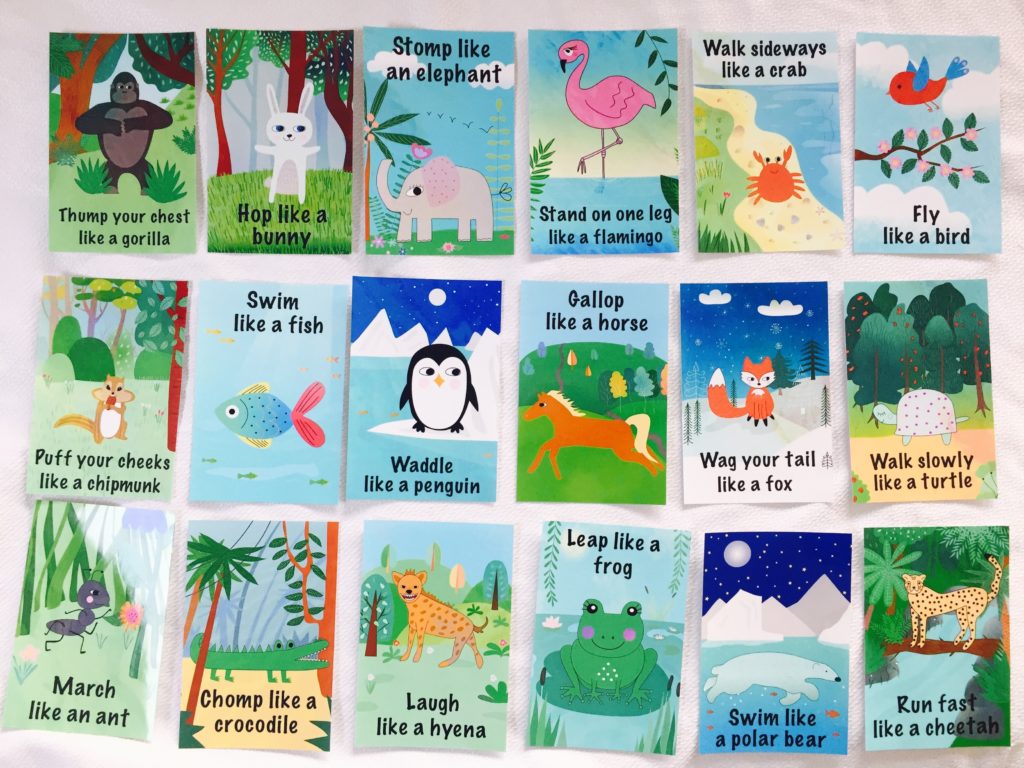
-
Animal action cards
These animal action cards are hit with Scarlett. She started to do some of these action when she was about 15 months old, and now at 23 months old she is able to do almost all of them besides standing on one leg like a flamingo, and puffing her cheeks like a chipmunk. She asks me to play with these cards over and over again. I showed her how to do the actions the first time we played with these and now she does them on her own. It’s fun for the whole family, we clap when she does it right, and she gets to let her energy out in a fun way. The digital version of these cards is available here and a printed version is here.
10. Foreign languages stimulation.
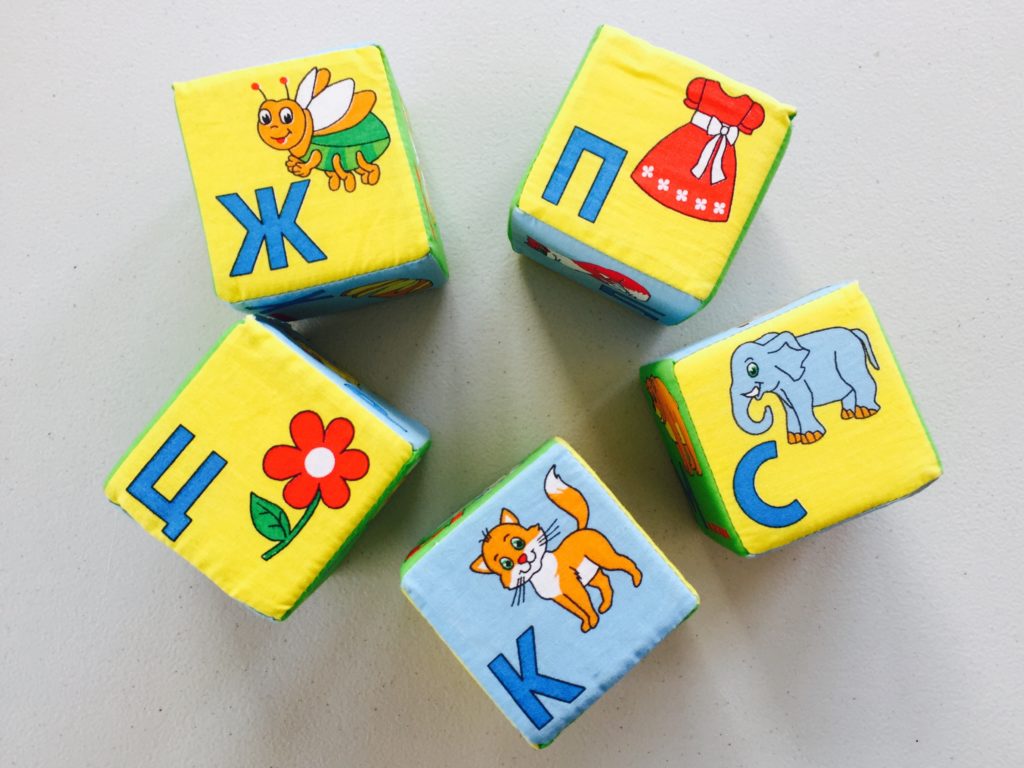
This block of activities can include listening to songs, poetry or stories in foreign languages. These activities will not help the child to speak the language but will give the child the base should he or she decide to pick it up later in life.
Before I read the Shichida method, I was avoiding introducing a new language to my child since she is bi-lingual already and I wanted to avoid the confusion with other languages. But after reading the book by Dr Shichida, I decided to take her to a Spanish story time once a week, and once in a while I turn on a short cartoon for her in a foreign language.
11. Speed-Reading of flash cards.
This is one of the most important exercises from Shichida method and one of the hardest ones to implement at home. It develops the right brain’s imaging activity by inputting massive amounts of information as fast as possible. The left brain works at low speed rhythm while the right brain works at high speed rhythm. When massive information is input at a high speed, the right brain responds to it naturally and imaging capability is developed. As a result when you try to remember something, an image will appear in your brain, containing the information.
Speed-reading involves showing 100-150 flash cards to a child with an interval of 0.5 second. Since the flashing of the cards is happening very fast, the left brain doesn’t have enough time to process it and that’s when right brain gets involved getting the stimulation needed to activate it’s powers. Flashing of cards can be broken down into a few sessions throughout the day if the child doesn’t sit through all of it at once, but the same cards should not be repeated the same day. The problem is that flash cards ideally should be non-repetitive for each session. Non-ideally, it’s ok to repeat the same cards for one week, after which they should not be reused. Of course, it’s not realistic to have these many flash cards at home.
What we do:
We have about 10-15 sets of flash cards. I split them into 7 days of the week, so we have repeating flash cards every 7 days, which is not ideal. I do flash them very fast in front of my child, simultaneously reading the names of the objects. I wrote about the flash cards that we liked above, but here is that list again:
- My First Touch And Feel Picture Cards: First Words
- My First Touch and Feel Picture Cards: Colors and Shapes
- My First Touch and Feel Picture Cards: Things That Go
- My First Touch and Feel Picture Cards: Animals
- My First Touch and Feel Picture Cards: Farm
- Alphabet Pocket Flash Cards
- Picture Words Pocket Flash Cards
I also found some digital flashcards on youtube. This is one of the examples that has the correct speed:
Some other youtube videos have flashcards but are flashed slowly following Glenn Doman method (left brain education) so you can manually change the speed of the video on youtube by clicking Settings > Speed > 0.5.
You can search youtube for “Shichida flash cards” and select the ones you like.
I also downloaded a few apps on the iPad that do flashcards. We use these apps for now. You have to manually click or swipe yourself to change each card though – but at least you can control the speed that way.
I see a big difference in my child’s interest in flashcards – if the cards are flashed fast, she is watching them – if I flash them slowly, she gets easily bored and walks away. So I like this idea but we are definitely not doing as many cards as recommended by Shichida method.
There is a website that has a database of 15,000 digital flashcards https://www.rightbraineducationlibrary.com. It’s great for following the Shichida method.
You might wonder why your child needs to know these many words – the answer is – flashing cards is done not for learning words but for training the right brain. The analogy would be exercising our body with weights – we use weights for exercising, but we are never actually planning to be carrying those weights around, we just want to develop those muscles.
One more thing to add – toy rotation. If the same toys are surrounding kids every day of their life, they lose interest really fast. Therefore in Montessori they do toy rotation – put some toys away for a while and only have a few available at a time. I did things a bit easier for myself, I bought 7 bins and organized our toys, activities and books into those 7 bins so each day we have a prepared list of things to do. You can check out my full post about toy rotation.
I hope you found some information useful. I personally loved Shichida method as soon as I read about it. Please note, I wrote this article from information I assembled from different sources and shared my interpretation of the method.
If you would like to be notified when my new blog articles come out, please sign up to my newsletter below.
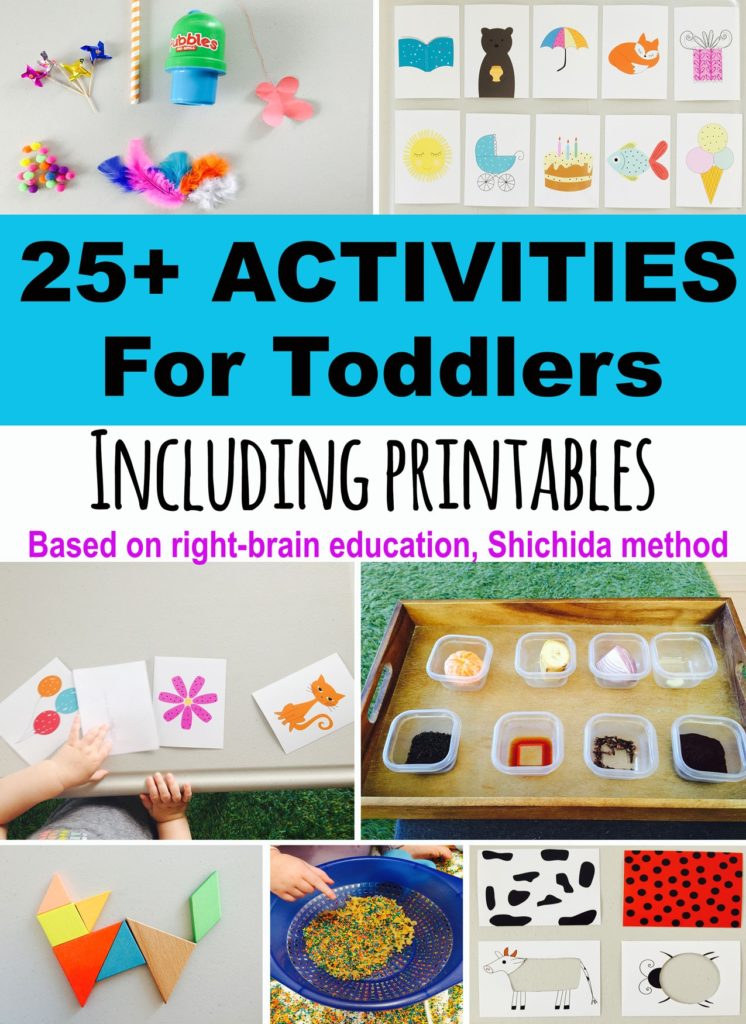
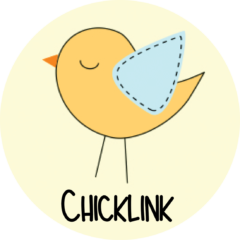

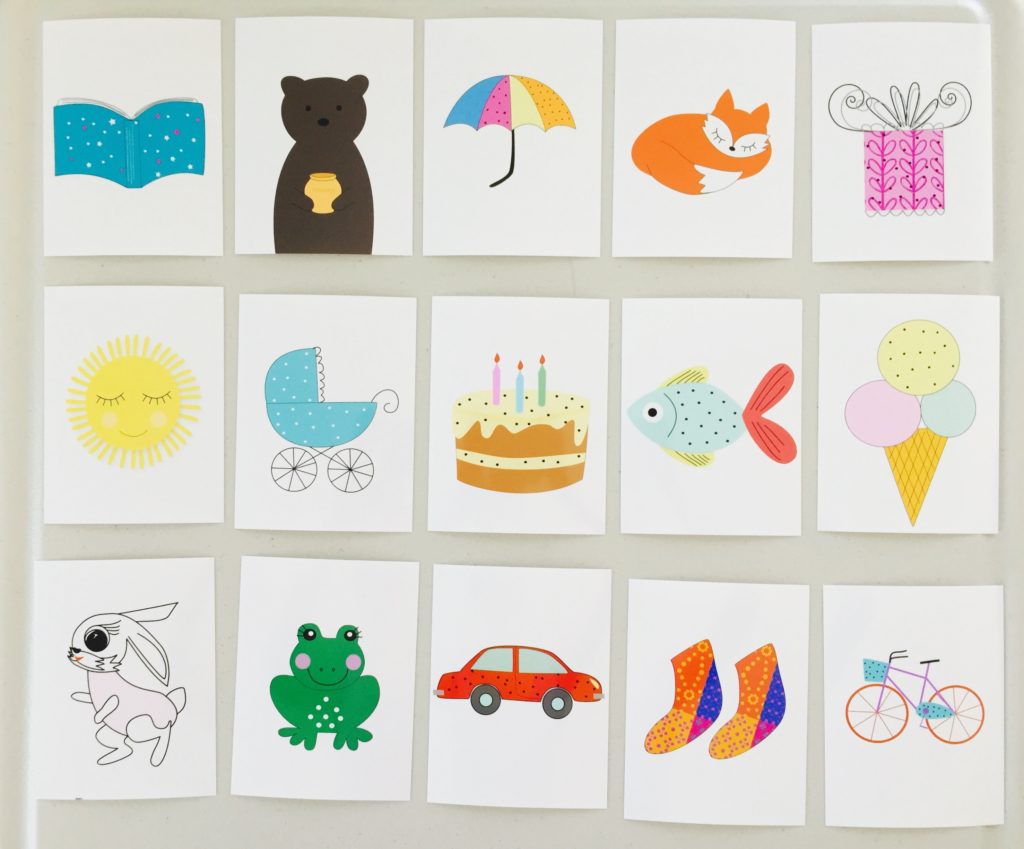





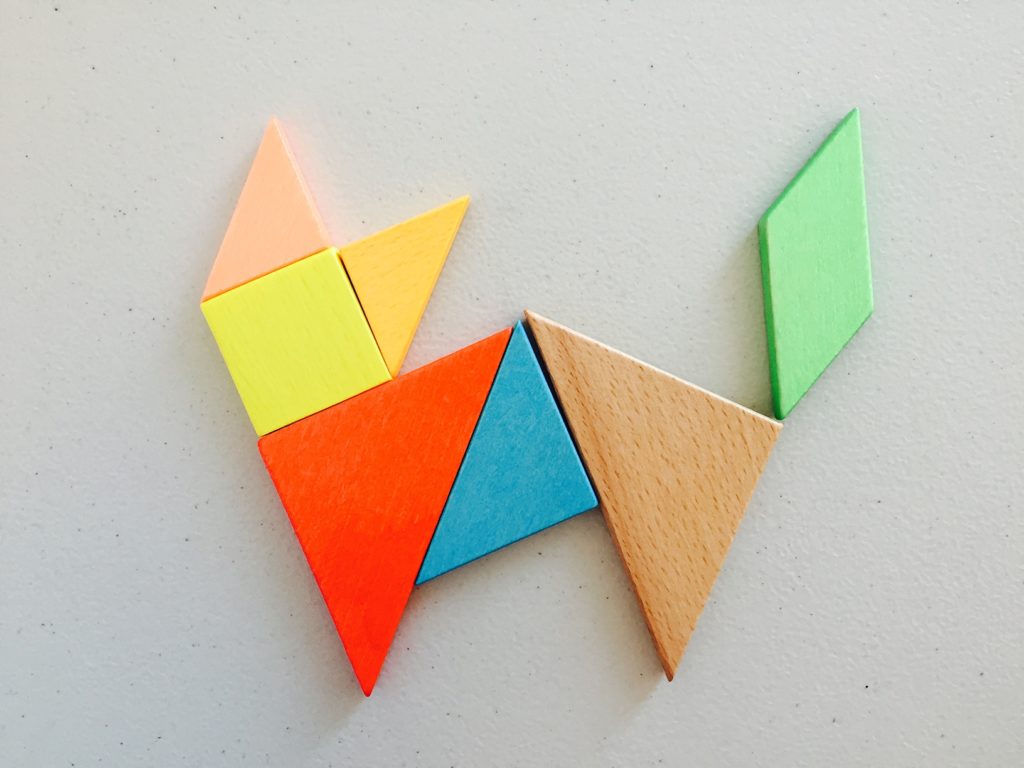
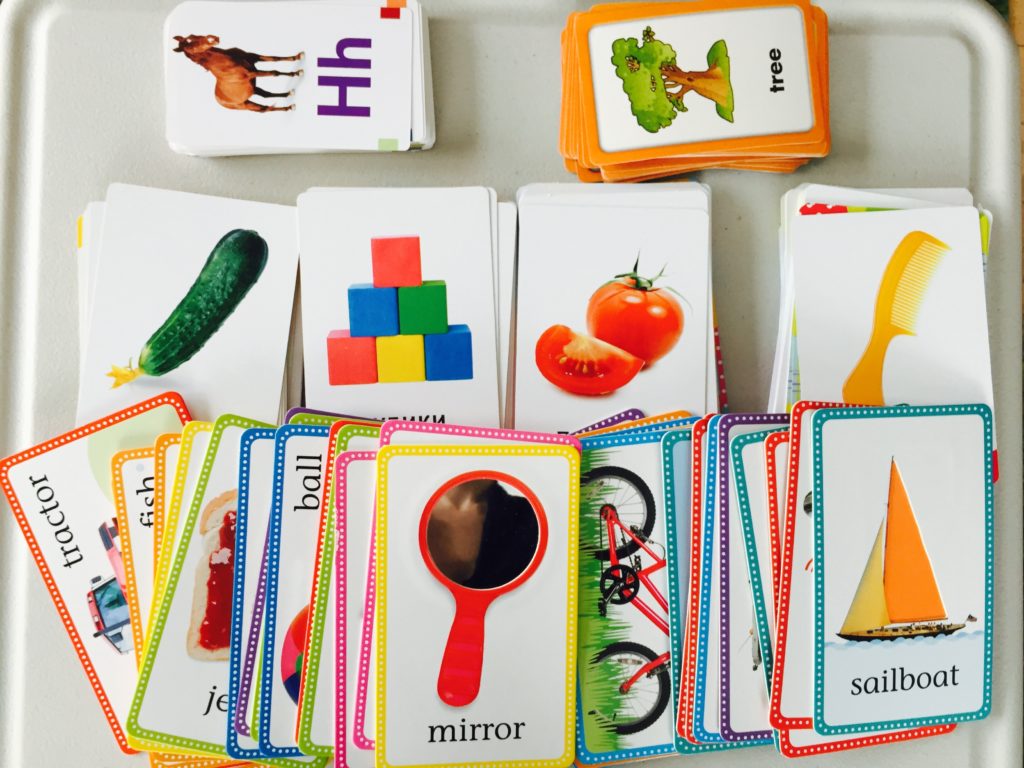
Thank you for reading! I’m glad you liked it.
hi wonderful blog congrulations:) ı don’t understand exactly how we use the owl cards .can you explain more detailed?thanks:)
Hi Emine. Download the file with owl illustrations that’s attached in the post. Cut it into cards. Show one card to your child. Put that card to the side. And then show 2 cards to your child – the one that was just put to the side and a new card. The child is supposed to try to remember which was the first card that was shown to him. Hope it helps!
At 19 months, did your daughter do this or was she distracted? at 20 months, my daughter just looks at the one she likes and ignores the others. or should this be started when the kid can speak well?
Hi Neha, It’s definitely hard for kids to concentrate on all of these activities at the age of 19 months. You can try some activities, and see which ones your daughter is interested in. In the beginning she might spend one minute for each activity, and it’s still helpful and will probably increase as she grows older.
Hi what a wonderful blog. Appreciate your efforts and your generosity for sharing everything. Did your 19 month LO do the recall memory card ( owl) exercise. My 20 month old runs away most of the times. Same with Mandalas. Is this normal?
Hi Neha, owl exercise might be too early for a 20 month old. You can try to offer it to your daughter again at one month intervals.
My girl is 19 month old .. but she sits for a task only for minute.. difficult to do some activities here.
Hi Supritha,
one minute is a good timing for a 19 month old. Your daughter might get interested in some of these activities more as she grows older, just keep trying with 2-week intervals. You can also spread the activities to be done throughout the day vs one sitting.
This is amazing! Thank you so much for sharing this method, I didn’t know anything about it. I’ll start applying it with my daughter Berenice.
I’m really glad you found it useful! I was really excited myself when I found this information 🙂
Thanks for the post!
I’m glad you liked it!
This is amazing. Thanks for sharing.
Thank you for reading! I’m glad to share!
I like your article! Nice info
Thank you! I’m glad you found it interesting!
Love this! I am making a list now what I need to prepare the activities. It is a little overwhelming because it is so much, but I think once you go through a few sessions it will all fall into place. I am so glad I found this.
I’m really glad you found it useful, Janette! I was overwhelmed in the beginning as well 🙂
I have a question regarding the speed reading of flash cards. Is the child supposed to repeat the 100-150 flash cards in the correct order after showing him all of them? And do the flash cards have to be of the same topic? Like farm or vegetables etc or can they be anything all mixed up? My child is not speaking yet, is it still recommended to do this activity even though he can not repeat it yet?
No, the child is not supposed to repeat the flashcards, you just have to read the words that you are showing to the child yourself. This exercise is done to stimulate right brain with different kinds of information in the form of the images and to develop passive vocabulary. A good analogy I read somewhere is that when we exercise our muscles using weights, we don’t necessarily plan to be lifting weights in our everyday life, but we do these exercises to develop our muscles. Same thing here – the main purpose is not to memorize words but to develop the abilities of the right brain. I do cards for the same theme usually. Sometimes I go through a few different themes.
Loved it. It is really useful. I will definitely try these. Thanks for posting.
I’m really glad you found it useful! I’m glad to share!
Thanks for this.. Really excited to try! just a question would you only play the alpha waves music for 2min or during the duration of all activities?
I’m glad you liked the post! I turn on the alpha waves for the duration on the activities, even though sometimes we spread the activities throughout the day.
Hi may i know how to do flash card? Or u just buy it? Totally no idea how to do flash card. Pls help
The easiest way is to buy some flash cards. I pointed out a few recommendations in the article.
You can also do them yourself but that requires great amount of time since you will need to look for images, type the names of objects underneath it, print them and cut them into flash card size.
In the article, I also listed a few digital resources – you can show flash cards to your child on your computer or tv, unless you practice a fully screen free home. I am fine using digital resources since it’s only for a few minutes a day.
My new favourite blog!! I love your dedication. Did you ever decide to sign up to rightbrainlibrary? Love from Scotland 🏴
Thank you for kind words! I actually didn’t sign up to the righbrainlibrary, I was using youtube videos that are flashing cards and flashcards that I bought. Since I also speak russian to Scarlett, there are a lot more resources for flashcards in russian that I found.
Great Article! Thankyou so much for the tips.
I’m glad you found it useful!
Bellissimo articolo, complimenti!
Thank you!
Thankyou so much for this amazingly put together article. I have a 19mnth old Daughter and i am excited to try all these activities with her!
Thank you! I’m really glad you liked it! I was excited myself when I found this information 🙂 Glad to share.
Thank for sharing these wonderful ideas. Do you know something about Shichida 63-day maths programme?
There are videos on youtube where you can watch math cards. Just search it on youtube if you are ok showing screen to your child.
Thank you very much! I am glad I found your site. I will be doing these activities with my child. Could you let me know where you ordered the book online? I would like to own the book 🙂
You can see the list of books on their website: https://shichidaeducation.com/lmp. I think there are only 2 books in English. You have to send them an email saying that you want a book and they will send you an order form. I got this book: Children can Change through Right Brain Education.
A really well put together article, thanks for the clarity and links all in working order. I was looking for big and small cards to put in a big and small basket for my 18mo when I came across the article. My personal opinion is that not all of these activities are appropriate for young children and especially not in an intense ‘learning block’, but I think that if you follow your child’s interests and pick and choose some activities they would get a lot out of it.
Absolutely! This is just the model and the activities are suggested. We spread the activities throughout the day too!
I am so impressed with your site. I feel like each article that I’ve read so far fits perfectly with what I need/my child needs. Thank you for your dedication and time you’ve put into your blog. It is truly amazing and inspirational to read.
Thank you so much for kind words!!!
This is just superb! i have been looking around for something like this for my son. Thank you so much. Thank you for taking the time out to right all of this. YOU HAVE BEEN SUCH A GREAT SOURCE OF INSPIRATION AND HELP. just amazing
I’m so glad it helps parents! Glad to share 🙂
My son is 21 months. In recent weeks it has become clear that having a few simple toys or activities available is the way to go ( as opposed to having a bunch of electronic, push button toys). At this stage, these types of activities available seem to help him calm down and concentrate a little bit. Thank you for sharing so many good options that we can do together, and that are inexpensive or can be made at home.
I’m glad the information was helpful! And definitely, smaller amount of toys helps kids concentrate better, therefore in Montessori they constantly rotate toys so only a few of them would be visible to kids.
These activities are great. I am having trouble with some of your links like the animal skin cards. If these items are no longer free can you find another link to the source where we can find them? I’d love to get some if these activities.
Hi Amanda! I’m sorry the link didn’t work and thank you for letting me know. I just tested the link and it works for me. It initiates the download of a zip file. Perhaps you have a pop-up block? Does anyone else have issues with links? I’ll email you the file to your yahoo email address.
So interesting but I can’t find the book…
Looks like they moved books to a different page on their website: https://shichidaeducation.com/lmp/. I’m not sure if they are still shipping them worldwide. You can email them and ask.
Thank you for sharing…great article!
Thank you for reading! I’m glad you liked it!
Hi,
Do you know where do we get mandala activity set?
Hi Smitha, we are not using mandalas yet, but I saw that this website has them for sale: http://www.homeeducation.sg/everyday-mandala
Oh Blueberry, where were you when my kids were little? Alas, you must’ve been but a flicker in grandpa’s eye. Would loved all these tips and tricks. But I am planning to use them on my neighbor’s twins. Thanx so much. Yours is the best one I’ve come across so far!
Thank you Suzie! I’m so glad you found them useful!
Amazing post, thank you so much for your incredible and so complete work, thanks to you I will increase tge variety of activities with my 20 month baby 😊.
I’m so glad you found it useful! I hope your baby enjoys the activities 🙂
This is a great article with a lot of useful information. I love those activities. I can’t wait to play with my toddler. The 50 picture cards for linking memory game/ memory grid are quite useful. Just wondering if there are any more of those picture cards that can be printed?
Thank you for sharing.
Hi Clivea,
Sorry for late response. I don’t have any more cards for memory game, but you can use any flash cards to play this game as well. I’m glad you like the game!
Hi, thank you for your dedication. I’m very impressed and I am definitely going try all of these with my toddler. I do have a question on flash cards, I made plenty of flash cards already but just pictures the names were printed on the other side , is it okay to use these flash cards or should I add the names? Thank you!
Hi there! You don’t need to have the names printed on the front side, as long as you read the names while you are flashing the cards. Hope it helps!
Thank you so much for putting this together! So much great information to go through. My daughter is 20 months old and also very active. I have been trying to do activities with her for the past few months, but it’s a challenge because she often gets up and walks away too!
I especially liked how you said 30 mins total in the day is enough. As a parent, I get concerned that I’m not doing enough with her. I usually only have time to do 30 mins of activities with her so it’s great to know that that’s actually enough!
Thanks again
I was relieved to find that information too, so I’m happy to pass along!
How do I find more info about this Shichida method? Everything I saw was in Chinese.
I got a book from the official Shichida website: https://shichidaeducation.com/lmp/. You’ll need to contact them in order to make a book order, but they do ship worldwide.
Lovely article. so useful for mothers and fun for toddlers . Thank you for sharing.
Great article! Thank you for sharing… i’m excited to try it with my son… lovelots from Philippines!
I Loved this article!
You just made my life easy, and my baby smarter!
God Bless You!
Fantastic article! Thank you
WOW!!! thank you so much for this. I stumbled on Shichida method and was amazed by how limited information was. I really appreciate this. I’ve tried downloading zip files however not able to access many of the contents. I hope you see this and are able to assist. Thanks much
I’m glad you found this article helpful! I’m sorry some of the downloads didn’t work. Could you please let me know what happens – are you able to download the zip files but they don’t open up?
Great article with the right amount of information for us to get started with. I’ve watched a few videos on the Shichida method, but the content was too overwhelming to implement any. This blog is great in terms of giving us practical techniques of engaging babies. Thanks a lot!!
Thank you very much for the detailed information. We will gladly place link to your on our website
Thank you very much for the excellent details
It is a great blog! Thank you so much for all the ideas. I wish those digital versions of the cards were still available. I downloaded it but not working.
Hi there! I’m sorry one of the downloads didn’t work. Could you please let me know which one? I just checked links for the downloads and they all seem to be working fine. I would appreciate if you could let me know which file you had trouble with.
Hi there, I love what you did in your blog, it looks like a lot of work and it’s so nice of you to share your information and tips. I’m excited about doing everything you mentioned. Thanks again 😊
A very useful article. My kids are 2 years old and I am soooo happy for all your information provided since there is little about this method on the Internet. Thank you! You are amazing!
I’m glad you found it useful! Thank you for reading!
Thank you so much for putting this information together. I’m excited to get started!
Thank you so much for the time you have spent providing all this and more. I have started with my 20 month old and she is getting most of it and loves it. We do each one on rotation 1 min a day and she always wants to do more. Thank you
Thank you so much for your post! The overview with examples is extremely helpful! One question I had was about the memory grid in a house. I downloaded the cards you linked, which were PDFs. When I went to use the website you mentioned, I couldn’t upload the PDFs to print since they only accept photo files. I then figured out a way to save PDFs as images and uploaded them, only to realize how crazy/cumbersome and expensive it would be to try to re-size every image from each page. At that point, it would be cheaper to buy some premade cards from Amazon. Would you mind explaining how you printed from the website? Was it a long process? I think I must be missing something!
Thank you again for all of your ideas!
Hi Elizabeth,
If you follow the link under the memory grid in a house section, it will download a folder for you that has both jpg files and pdf files. You can then use the jpg files for printing. Hope it helps!
Thank you for your great article!
I have a few questions:
1) are the cartoon pictures/drawings all right for those games? I thought that right brain methods exclude them and recommend only real images with no background and simplified font (“Montessori type”) and now I feel confused…
2) should/can the flashcards which we use be with captions under them or not?
3) You’ve written that we can divide the tasks/games and do them in different parts of the day. Can we mix the order of them? If you come back to the Shichida activities after a few hours, do you start with the music and blowing activities again?
4) Is it okay to ommit some of the points? I’m asking because my son doesn’t want me to turn any new music to him, so listening to music with alpha waves is simply impossible.
5) What’s the general name of this type of cards which might be an introduction to mandalas (owls)? I mean the very similar cards which differ with only one detail. I can’t find more of them, but it’s probably because I don’t know the English name for such cards.
I would be grateful for your answer, although I am aware it’s quite an old article…
Hi Anna,
Thank you for your questions! It’s been a while that we used the Shichida method, my daughter is 6 years old now! But I’ll respond to your questions to the best of my knowledge, even though my answers may not be exactly correct…
1. As far as I understand, the pictures should be used for speed-reading flashcards exercise, but it’s ok to use illustrations for the other exercises. I looked at the pictures from Shichida school classes in Indonesia, and looks like they are using cards with illustrations in their classes.
2. Yes, cards can have captions
3. We personally did the activities in different order and only did the blowing activities once a day
4. I think it’s ok to omit music. It just helps to relax but not required
5. Unfortunately I would not be able to help with the name of these cards. I saw this exercise at one of the Shichida schools and illustrated those cards myself, but probably “spot the difference” type of exercises are the closest.
Hope it helps!
Olga
Thank you very much for your reply. My son is 2 years and 4 months old. We’ve been playing for over a month now. Your explanations are really helpful. I’m planning to b uy access to the Right Brain Education Library when I save a bit;)
How long did you play with your daughter this way? Do you feel it helped her?
Warm regards,
Ania
Hi Ania! I followed this method till my daughter turned 3 years old – this is when I went back to work and didn’t have as much time to do the activities with her anymore. It’s hard to say how much it helped. She does have an exceptional memory but I’m not sure how much it’s due to the exercises that we did. What I really liked about this method is that we had a daily structure of activities, and that kept me sane. Hope it helps!
I absolutely love these activities! I am staying home with my 2 yr old twins and can’t wait to try these! I’m wondering since you do this for about 30min, the rest of the day is your child playing with the items in their toy box that you rotate each day? Thanks!
Hi Milou,
I’m so glad you found these activities helpful!
We usually don’t sit down to do 30 minute of activities at a time, we spread them out during the day, and do a bit at a time, as long as they all total at least 30 minutes. And yes, we mostly use activities/toys from the box of the day!